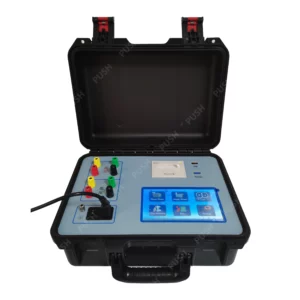What measurement parameters does it assess in a transformer’s turns ratio, including voltage and current ratios?
A Turn Ratio Tester is an essential instrument for assessing the turns ratio of transformers, providing valuable data about a transformer’s primary-to-secondary winding turns relationship. It operates by applying a known voltage to the transformer’s primary winding and measuring the resulting voltage and current on the secondary winding.
Here’s how it works, including the measurement of voltage and current ratios:
Measurement of Voltage Ratios:
- Connection to Transformer Windings: To perform the turns ratio test, the Turn Ratio Tester is connected to the primary and secondary windings of the transformer. The primary winding is energized, typically by applying a low-voltage AC signal.
- Voltage Measurement: The tester measures the voltage on the primary winding while applying a known voltage. This is typically done by dividing the primary voltage by the secondary voltage. The tester’s control unit calculates the voltage ratio.
- Calculation of Turns Ratio: The turns ratio is calculated as the ratio of the primary voltage to the secondary voltage. The tester typically displays the turns ratio as a numerical value, which indicates the number of turns in the secondary winding per turn in the primary winding.
Measurement of Current Ratios:
- Connection to Transformer Windings: For measuring current ratios, the Turn Ratio Tester is connected to the primary and secondary windings, just as in the case of voltage measurement.
- Current Injection: The tester injects a known current into the primary winding.
- Current Measurement: The tester measures the resulting current in the secondary winding. It does this by comparing the current injected into the primary winding with the current detected in the secondary winding.
- Calculation of Current Ratio: The current ratio is calculated as the ratio of the primary current to the secondary current. This information helps assess how the transformer transforms current from the primary to the secondary winding.
Safety Precautions:
When conducting a turns ratio test, especially when dealing with high-voltage transformers, safety precautions are essential:
- Ensure proper isolation and grounding to prevent electrical accidents.
- Use appropriate personal protective equipment (PPE), including insulated gloves and barriers.
- Follow safety protocols and guidelines for working with high-voltage equipment.
The accuracy and precision of a Turn Ratio Tester are critical in obtaining reliable measurements. Calibration of the tester using recognized standards and reference sources is essential to maintain its accuracy. High-quality Turn Ratio Testers are typically used in electrical engineering, maintenance, and quality control to assess the performance and condition of transformers, ensuring they operate within specified parameters and meet industry standards.
What safety measures and precautions should be followed when using a Turn Ratio Tester?
Safety is a top priority when working with electrical testing equipment, including a Turn Ratio Tester, especially when dealing with high-voltage transformers.
Here are important safety measures and precautions to follow when using a Turn Ratio Tester:
- Training and Qualifications:
- Only qualified and trained personnel should operate the Turn Ratio Tester. Ensure that operators are familiar with the equipment, its operation, and safety procedures.
- Personal Protective Equipment (PPE):
- Wear appropriate PPE, including insulating gloves, safety glasses, and any other required safety gear. The specific PPE may vary depending on the voltage levels and the environment in which the test is conducted.
- Isolation and Grounding:
- Ensure that the transformer being tested is properly isolated from the power source and fully grounded. Turn ratio tester Verify the effectiveness of the grounding system.
- De-Energization:
- Before connecting the Turn Ratio Tester, confirm that the transformer is de-energized and disconnected from the power source. This is crucial to prevent electrical accidents.
- Visual Inspection:
- Conduct a visual inspection of the transformer and the test setup to identify any visible signs of damage, wear, or loose connections.
- Test Area Safety:
- Ensure that the test area is well-ventilated and free from hazards. Remove any flammable materials, and provide appropriate fire extinguishing equipment.
- Emergency Procedures:
- Have a clear understanding of emergency procedures, including how to de-energize the system in case of an accident or malfunction.
- Turn Ratio Tester Inspection:
- Prior to use, inspect the Turn Ratio Tester for any damage or signs of wear. Make sure all cables and connectors are in good condition.
- Correct Connection:
- Double-check the connections to ensure they are correct and secure, both at the transformer and on the Turn Ratio Tester.
- Safety Barriers:
- Use safety barriers and warning signs to establish a safe zone around the testing area to prevent unauthorized access.
- Remote Operation:
- If available, consider remote operation options for the Turn Ratio Tester to reduce the operator’s proximity to the high-voltage equipment.
- Calibration and Maintenance:
- Regularly calibrate and maintain the Turn Ratio Tester according to the manufacturer’s recommendations to ensure its accuracy and reliability.
- Documentation:
- Maintain records of the testing process, including safety checks, to provide a clear audit trail of the testing procedure.
- Emergency Response Plan:
- Have an emergency response plan in place in case of accidents, electrical faults, or unexpected events. Ensure that personnel know how to respond in case of an emergency.
- Safety Guidelines Compliance:
- Adhere to safety guidelines, standards, and regulations relevant to the operation of the Turn Ratio Tester and testing of high-voltage electrical equipment.
Remember that safety is a shared responsibility, and everyone involved in the testing process should be aware of potential hazards and take measures to mitigate them. Following these safety measures and precautions is essential to ensure the safe and reliable operation of a Turn Ratio Tester and the protection of personnel involved in the testing process.


Comments are closed.